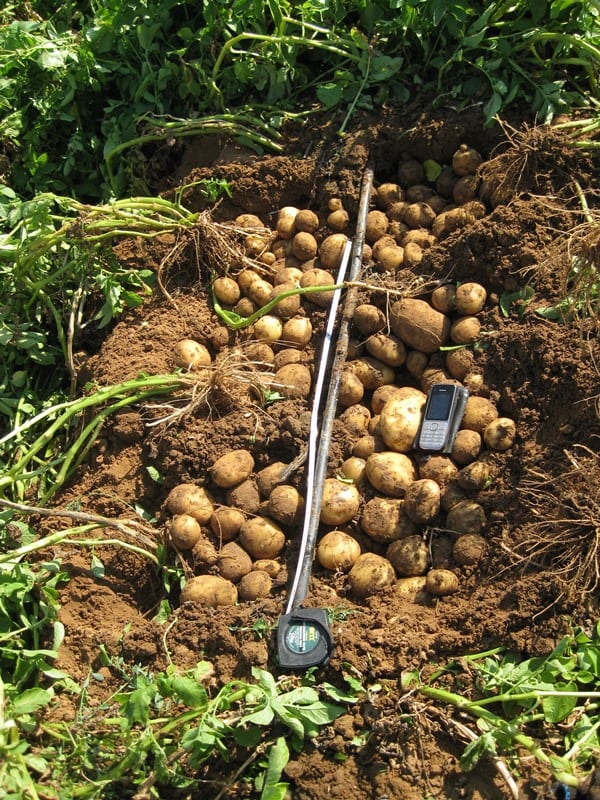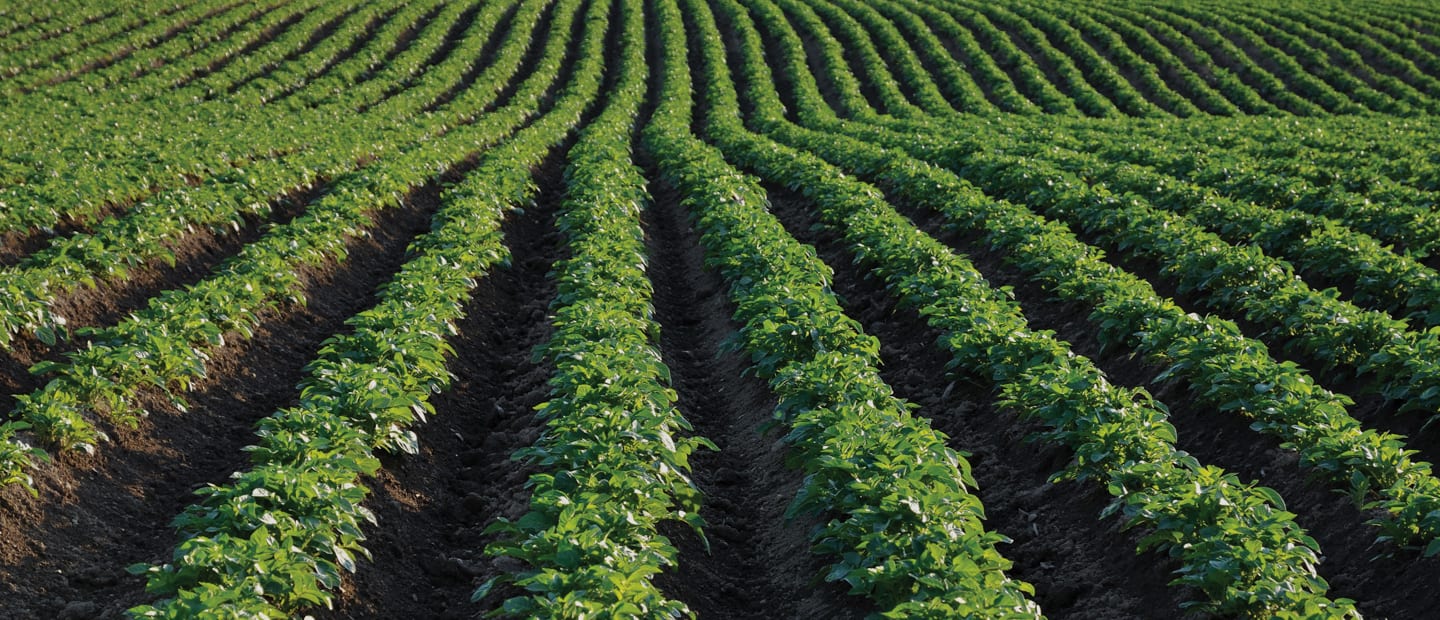Best Management Practices (BMPs) are the best recommended agronomic practices for growing a specified crop. These practices are based on research and experience and apply to potatoes under the specified agro-ecological conditions.
The recommended BMPs are not the only way to grow potatoes but are the best way determined by Netafim. The BMPs may change as additional proven research becomes available.

Agro-ecological situation
Climate
Conditions: Temperate, tropical and subtropical; cool season crop; day length: 12 hours
Saturation irradiance: 1200 E/m2/s PAR
Rainfall: 300 to 500 mm/annum
Relative humidity: 60 to 85%
Optimum ambient temperature: 14 to 24 °C
Soil
Soil suitability: Fertile, deep, well drained fine sandy to sandy loams
Optimum soil pH: 5.5 to 6.5
Available P: 35 mg/kg, Exchangeable K: 0.4 cmol/kg, exchangeable Ca: 1 – 2 cmol/kg, Exchangeable Mg: 0.4 cmol/kg
Organic carbon: 1.0 to 1.5
Soil bulk density: 1.3 – 1.4 Mg/m3 favor better root penetration and better tuber development and soil water air relations
Groundwater table: Below 2.0 m
Critical soil salinity level (ECe): 1.7 dS/m above which yield decreases
Soil to avoid: Waterlogged, alkaline and saline soils
Crop rotation
Three-year rotation adequate to check weeds, diseases and pests and avoids yield losses. Without proper rotation yield losses are up to 30% due to soil borne diseases.
The best rotational crops are cereal grains such as wheat and oats, corn, sugarcane, rice and forages.
Varieties
Several varieties with significant differences in size, shape, colour, texture, cooking characteristics and taste are available depending on the country.
Important varieties: Russet burbank, Nicola, Yukon Gold, Desiree.
Planting material
Healthy whole, cut or mini tubers
Spacing
Inter-row spacing: 0.60 to 0.91 m
Intra-row spacing: 0.15 to 0.45 m
Optimum plant density: 75000 to 133000 plants/ha
Seeding rates
Varies with cultivar, market, moisture, planting date, seed size, seed age and cost of production. Generally 1.5 to 3 tons/ha.
Seeding depth 5 to 10 cm.
Land preparation
- Clod free seedbed with good tilth to express its tuber yield potential, SDI installation and optimal soil water air relations.
- Destroy the hard pan if any using either chisel plough or a subsoiler.
- Primary tillage by mould board plough or disc plough and secondary tillage by disc harrows, tyned harrows or rotavator to achieve proper tilth.
- Broad bed (0.8 m to 1.5 m) and furrow (0.30 m) system.
- Compost: 25 – 30 tons/ha
Planting for better stand, yield and quality
Poor plant stand registers low yield
Soil temperature at planting 3 – 16°C
Planting depth 5 – 10 cm
Weed control
- Managing weeds is critical for successful potato production.
- Weeds compete for light, water, nutrients, etc. and reduce tuber yields by 27% to 73% depending on the weed intensity.
- Critical crop: Weed competition period is initial 4 – 6 weeks.
- Integrated weed control program involving crop rotation, manual weeding, good seedbed preparation, soil solarization, maintenance of optimum plant population, mechanical intercultivation and herbicide chemical applications.
- Recommended pre-mergence herbicides:
Alachlor: 1.0 – 1.5 kg/ha & Metribuzin: 0.7 kg/ha - Recommended post-emergence herbicides:
Parquat: 0.5 kg/ha & Propanil: 1.0 kg/ha
Irrigation system
Drip version: Surface or subsurface drip irrigation (SDI) combined with fertigation. Fertigation is the application of plant nutrients through an irrigation system, also known as NutrigationTM.
Drip product: DripNet PC, Super typhoon, Dripline 17009
Dripline spacing: 0.9 m for 1 lateral per each crop row and 1.8 m for 1 lateral per two crop rows
Emitter spacing: 0.30 m to 0.40 m
Emitter flow rate: 0.6 LPH, 1.0 LPH, 1.6 LPH and 2.0 LPH depending on soil texture
Crop water requirement & Irrigation scheduling
Estimate crop water requirements as a product of daily reference crop evapotranspiration by Penman-Monteith method and crop coefficient for a given day according to the plant developmental stages.
Begin with 0.5 Kc of daily ETo in the initial period, raise it to 0.8 at vegetative, stolonization and tuber initiation, 1.1 at tuber bulking and it decrease it to 0.7 at harvest period of potatoes.
Daily crop water requirement: 4 to 5 mm/day.
Seasonal crop water requirement: 150 to 700 mm under range of environments.
Irrigation scheduling: 30 cbars using tensiometers installed at 20 cm soil depth maximize tuber growth and grade and yield.
Fertigation
Apply mineral fertilizers based on the targeted yield, leaf analysis results, fertilizer experiment results, leaf deficiency symptoms, nutrient uptake, soil analysis results, and nutrient recycling.
Nutrient uptake:
3 – 4 kg N
1 – 1.5 kg P2O5
4 – 6 kg K2O
0.2 kg CaO per ton of tuber yield
0.3 kg MgO per ton of tuber yield.
Optimum leaf nutrient levels:
10,000 – 15,000 ppm N
0.17 – 0.22% P
7.0 – 8.0% K
0.15 – 0.30% Mg
0.4 – 0.6% Ca
0.15 – 0.20% S
10 – 20 ppm B
2 – 4 ppm Cu
20 – 40 ppm Mn
20 – 50 ppm Fe
10 – 20 ppm Zn
Recommended nutrient dose per hectare:
80 to 120 kg N + 60 to 100 kg P2O5 + 250 to 400 kg K2O
For fertigation use water soluble fertilizers such as:
urea (46% N)
potassium nitrate (13% N & 46% K2O)
monoammonium phosphate (12% N & 61% P2O5)
ammonium nitrate (34% N)
Pests
- Important pests include Colorado potato beetle, potato tuber moth, leafminor, and cyst nematodes.
- Important diseases include late blight, bacterial wilt, potato black leg and other viruses.
- Detect outbreaks and identify problem areas by conducting routine patrols.
- Monitor economic threshold levels and apply appropriate plant protection measures.
Physiological disorders
- Internal brown spot: Irregular dry brown spots scattered through the flesh of tubers.
- Black heart: Breakdown of internal tissues and become black. – Hollow heart: Irregular cavity in the centre of tuber.
- Chilling injury: Discoloured blotches in the flesh of tubers.
- Freezing injury:Blue-black discontinuous ring in the vascular region.
Harvesting
- Maturity and harvest time are influenced by weather, market prospects and the labor situation.
- Optimum maturity is reached when most of the tubers attain optimum size and the skin is set.
- To ensure good skin-set, kill the vines using chemicals such as Gramoxone Extra applied at least 3 to 7 days before harvest.
- Most potatoes are harvested mechanically with potato combines.
- Harvest during dry periods.
- Avoid bruising, skinning, or cutting the tubers during harvesting
- After the harvest potatoes are hauled to the packing shed in bulk trucks, tubers are washed, sized and graded, then placed in bags or cartons for shipment.
Tuber yield
Under drip irrigation and fertigation a good commercial tuber yield is 50 – 60 tons/ha in spring and 35 – 50 tons/ha in autumn depending on length of growing season and variety.
Water utilization efficiency varies between 8 and 12 kg/m3.

